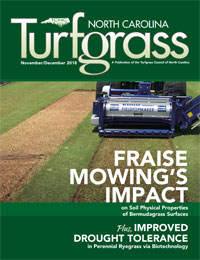Turfgrass Council of North Carolina | Nov/Dec 2018
This issue covers the impact of fraise mowing on bermudagrass surfaces. Also features biotechnology for improved drought tolerance and more.
READ THE ISSUE
Departments
From the PresidentWelcome, New TCNC MembersCalendar of EventsTCNC Deluxe MembersTCNC Membership ApplicationNC State Turf Team
By Raymond K. McCauley, Grady L. Miller, Garland D. Pinnix | Department of Crop and Soil Sciences, North Carolina State University
Excessive organic matter accumulation (>3 to 4% by weight) compromises soil aeration, drainage, turfgrass health, and playability. Aerification and vertical mowing are traditionally used to manage shallow organic matter.
Read More »
By M. Patel, S. Milla-Lewis, W. Zhang, C. Reynolds, M. C. Zuleta, R. E. Dewey, and R. Qu | North Carolina State University
There are over 40 million acres of turfgrasses in the US, consisting of home lawns, golf courses, parks, and recreation areas. Each year, we drench our lawns with enough water to fill the Chesapeake Bay!
Read More » 
